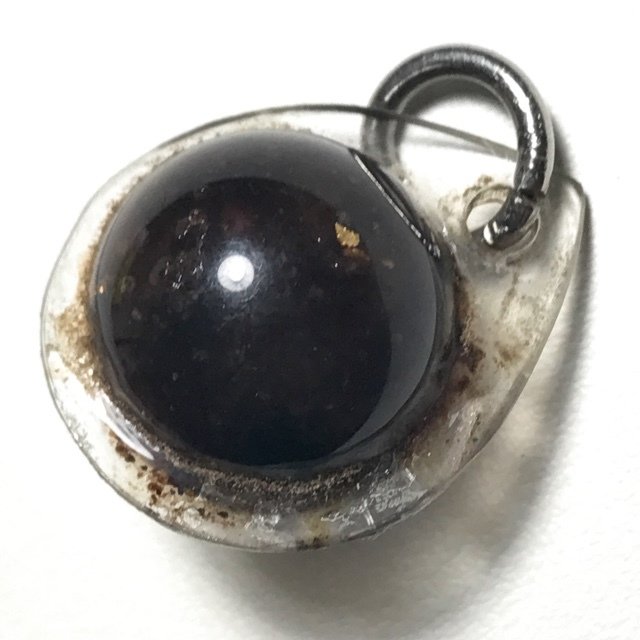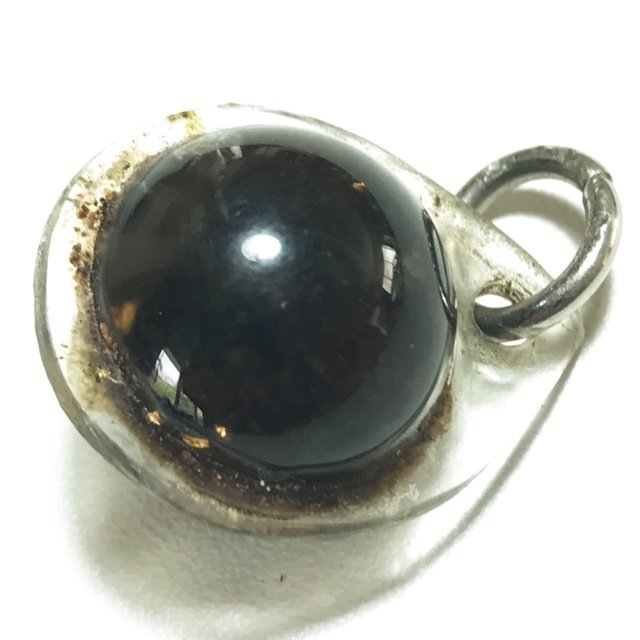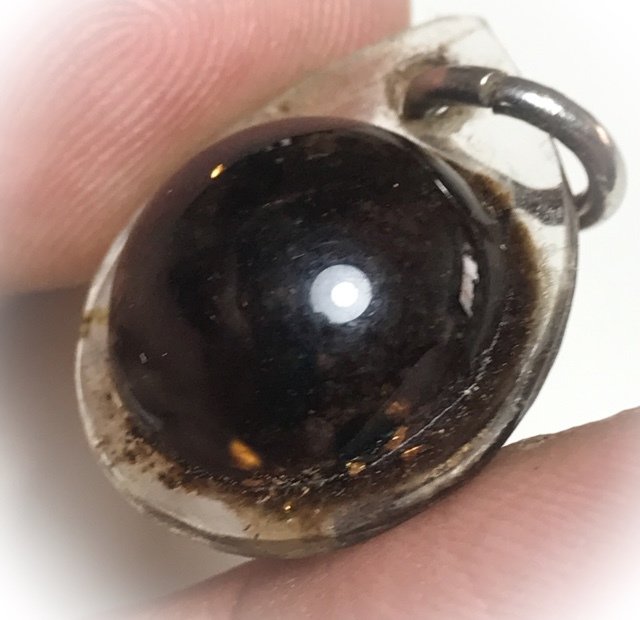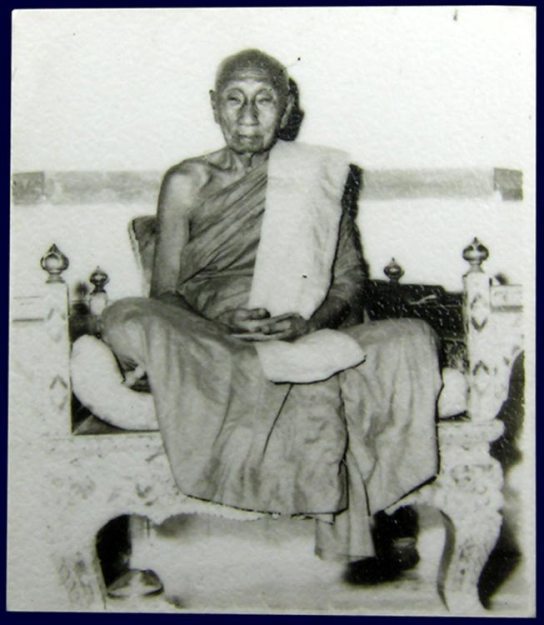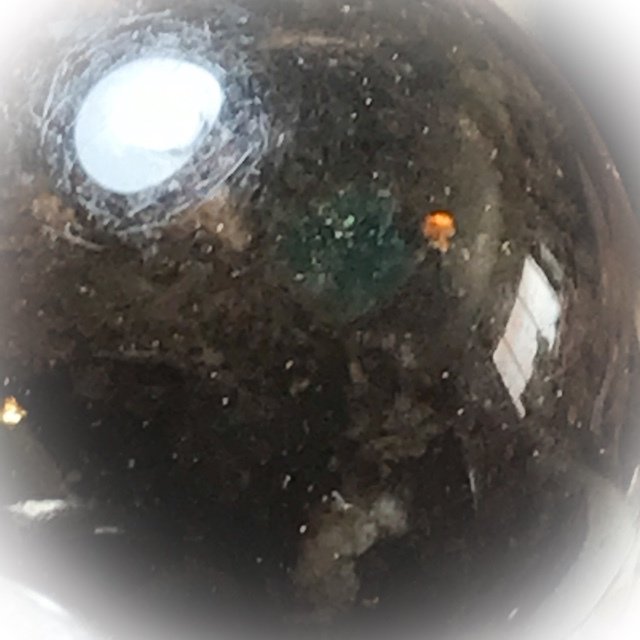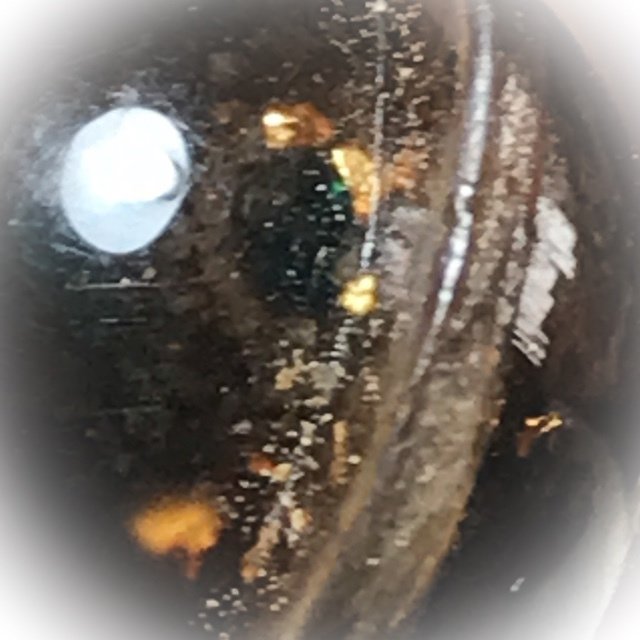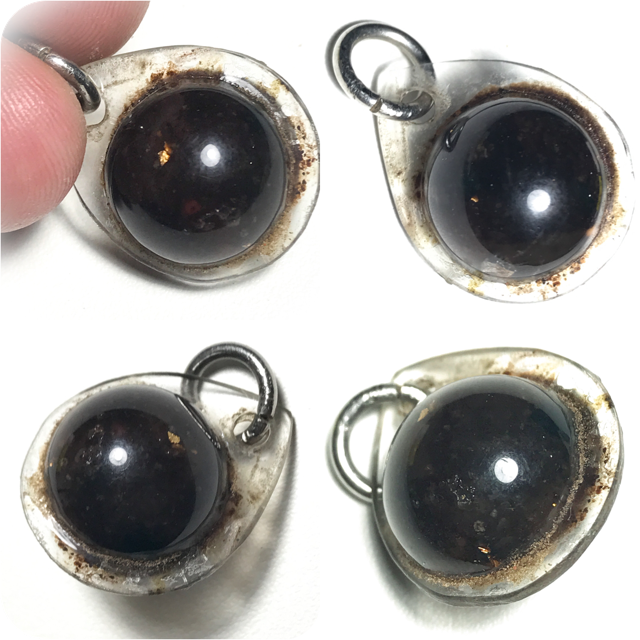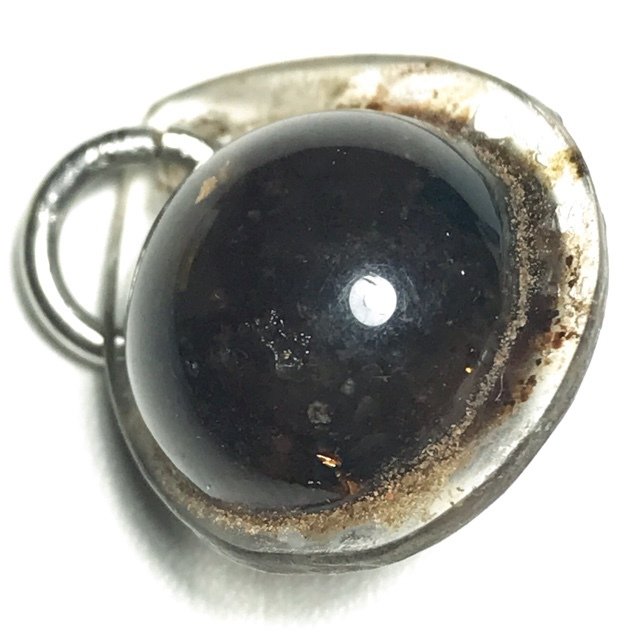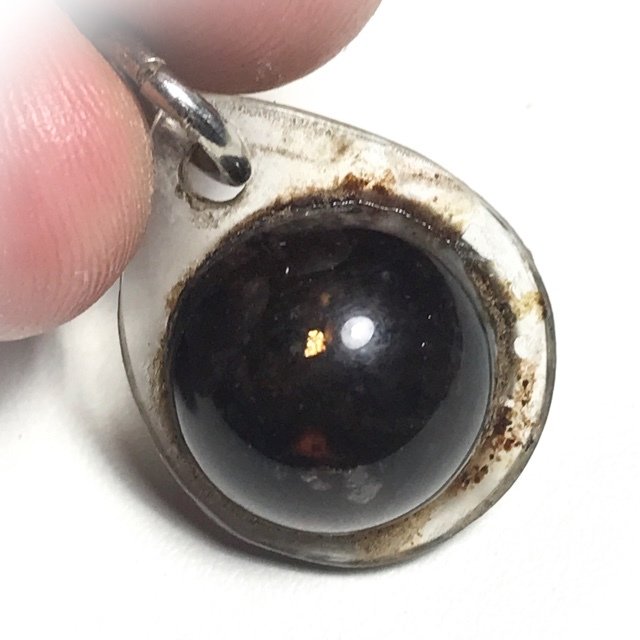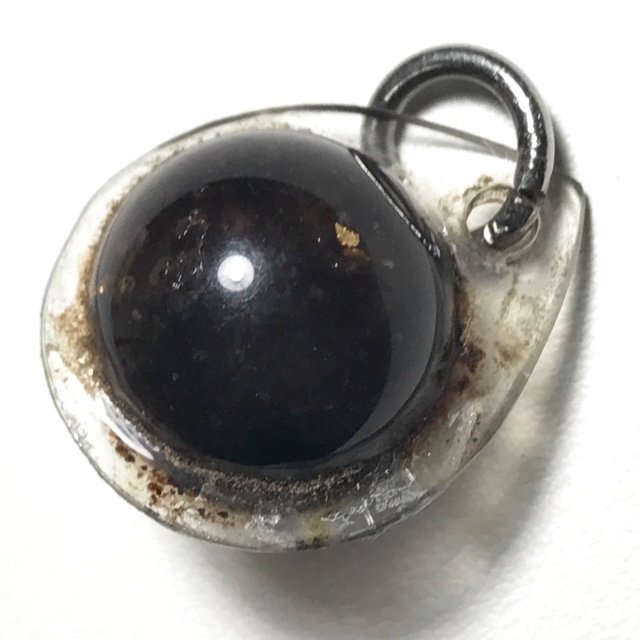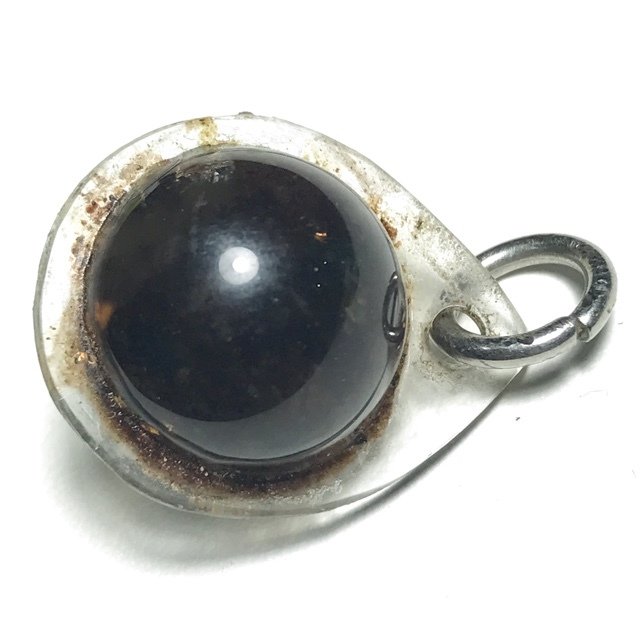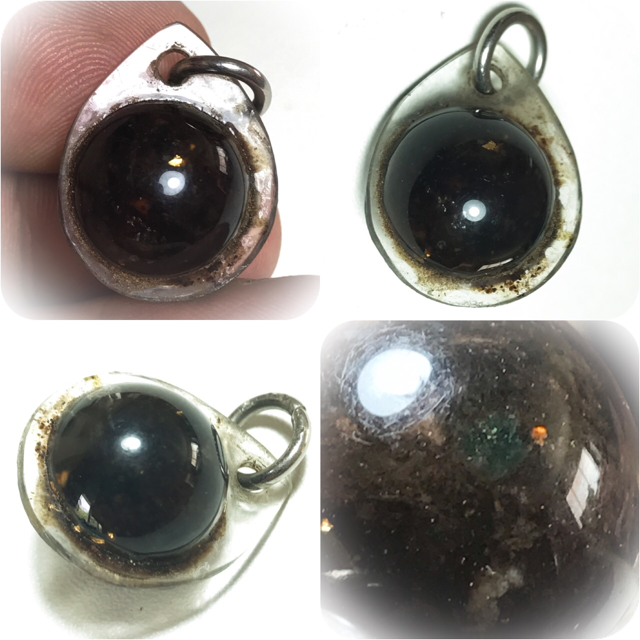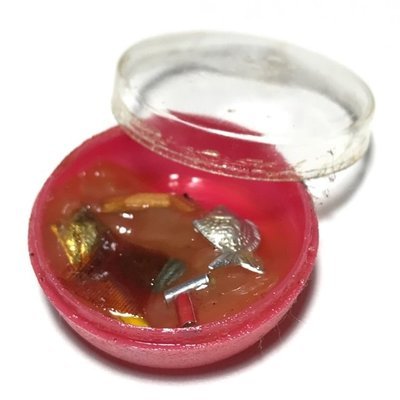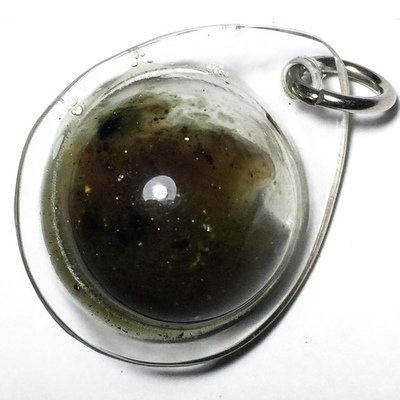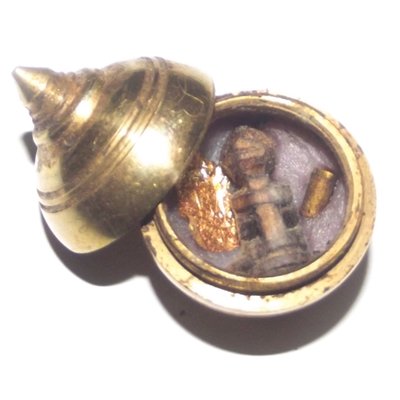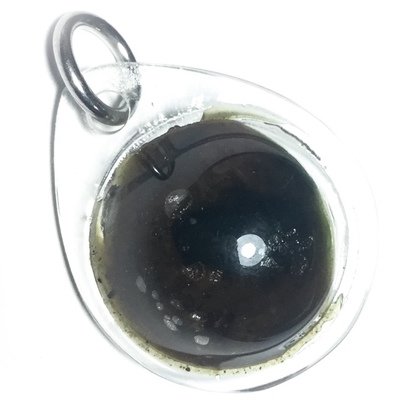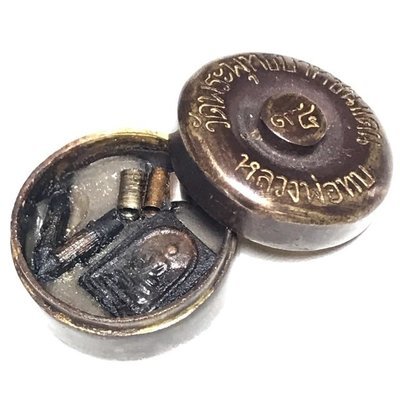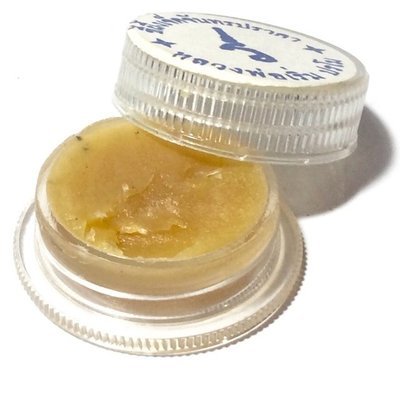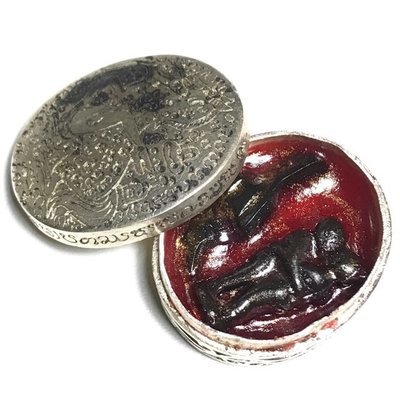Presenting a tiny but powerful and rare classic amulet from one of the Great Khao Or Masters of the 20th Century, Rian Glom Lek Hlang Chedi 2505 BE Nuea Tong Daeng Miniature Guru Monk Coin Por Tan Klai Wajasit
This Sacred amulet of the Great Khao Or Master of Nakorn Sri Tammarat, Master of Wat San Khan and Wat Pratat Noi, is a very rare amulet from Por Tan Klai’s 2505 BE Blessing Ceremony Edition, and is considered a ‘Jaek mae Krua’ type amulet (meaning ‘give to the kitchen maids and temple helpers’), which is suitable not only for men, but due to its miniature size, a perfect amulet for ladies or children to wear.

Rian Glom Lek 2505 BE Por Tan Klai Wajasit Wat Suan Khan
The 2505 BE edition of amulets of Por Tan Klai, is a highly preferred edition, which saw his famous ‘Rian Glom’ round Monk coin amulet with Chakra released, The Rian Glom Lek Hlang Chedi, and the Roop Tai Por Tan Klai Guru Monk Blesséd Photographamulets such as look om chan hmak and ya sen tobacco balls, and sacred powder amulets of various models.
A very rare and highly prized amulet for the devotees of Por Tan Klai to associate with his image and pray to him with a blessed image of the Guru, and the Chedi Relic Stupa on rear face for Buddhanussati and Marananussati. A powerful and Sacred amulet which has passed through the hands of the Guru and been blessed by him.
Por Tan Klai was one of the Top Guru Master Monks of the Last Century, and is considered one of the Four Great Masters of the Previous Generation of Lineage Masters of the Khao Or Southern Sorcery Lineage.
Kata Bucha Por Tan Klai
See Pheung Khiaw Look Om Sacred Green Prai Oil Potion Luang Por Tarb
See Pheung Khiaw green prai oil based potion of Luang Por Tarb, of Wat Mai Grabok Kheun Pheung. The Sacred Green Prai OIl Potion, is encased in spherical waterproof casing as a 'Look Om' wishing ball. The See Phueng Khiaw Green Prai Oil Potion of Luang Por Tarb, was, and still is one of the most highly preferred See Pheung Potions with serious aficionados of the 'Krueang Rang' talismanic amulets Genre.
Although it is still possible to find the odd example of his Legendary see Pheung Khiaw, it is becoming ever rarer these days to see one in circulation in the Public Amulet Exchanges.Luang Por Tarb released the See Pheung in pots with lids, and the Temple Comittee and Devotees encased some in waterproof spherical bubbles, and some was also used to fill small pots with lids, for use as a smearing balm. it is possible to find See Pheung Luang Por Tarb in both forms of sealed, or consumable encasement.
If the subject of the Genre of See Pheung, Nam Man Prai and Occult Talismans is raised in the circles of aficionados, when speaking of See Phueng, the name of Luang Por Tarb will be spoken, as one of the top Masters of his Era in this Genre of Puttakom Sorcery. Luang Por Tarb and his Amulets are highly renowned for their Metta Maha Niyom and Maha Sanaeh Power.
Kata Bucha See Pheung Luang Por Tarb (used for calling your wishes to come true - also used for smearing the potion if in pot version)
Jidt-Dti Midt-Dti Arahang Bpiyang Ma-Ma
Kata Bucha See Pheung Pok Dtid Dtua for invoking the See Pheung when carrying it with you on daily business
Ugaasa Sambpadti Jidt-Dti Midt-Dti Arahang
Luang Por Tarb (2420 - 2518 BE), was a Master Gaeji Ajarn Guru Monk of Yesteryear, famous for Metta Mahanyom Magic, and a well known companion in Magical Studies with the Great Luang Phu Tim, of Wat Laharn Rai.
Pra Kroo Athagosol or better known as 'Luang Por Tarb', of Wat Mai Grabok Kheun Pheung, in Ban Kaay, Rayong, was born in Ban Na Dta Khwan, Tambon Na Dta Khwan, Amphoe Mueang, Rayong Province, on a Friday of the sixth lunar month of the year of the Ox, in the Year 2420 BE.
Luang Por Tarb's Father was called Mr. Un Paetch Nakorn, and his Mother went by the name of Mrs. Chim Paetch Nakorn, who originally came from Jantaburi Province. Luang Por Tarb was the eighth and youngest of siblings. Luang Por Tarb was renowned as a Young boy for being very compassionate to other beings, and was often found guilty of having freed the fish which people has trapped for eating, and let them escape back to freedom, because he felt sorry for them.
Luang Por Tarb began school between the age of 4 and 5 years old, and continued his studies until the age of 20, when he was called into the Army to do his National service, where he remained for almost 4 Years. Here was where the Young Tarb decided to Ordain as a Bhikkhu (Buddhist Monk), to honor his Parents, and was Ordained by pra Kroo Samutr Saman Kun (Luang Por Hyaew), the then Abbot of Wat Pha Pradoo as his Upachaya.
Pra Ajarn Mak, the Abbot of Wat Na Dta Khwan was his Pra Gammawajajarn (Prompting Officer), and Pra Ajarn Ruam, of Wat Ban Laeng, was his Pra Anusawanajarn Witness. Once Luang Por Tarb was Ordained, he immediately showed great effort and strength in his diligent practice, and kept very strict rules with himself.
He studied the Dhamma Vinaya , and was already ablte to accurately interpret it for his Professors in Dhamma during his first year of Ordination, showing immense Prowess in his advancements. Apart from his advancements in Dhamma Vinaya and the Pariyatti Dhamma, Luang Por Tarb also made immense efforts to study and discover the secrets of Wicha Akom Buddha Magic and Thai-Khmer Sorcery. He received initiations into Wicha Akom from Luang Por Mak first, and then spent 2 Years of further training under Luang Por Hyaew, to complete his Mastery of the Various Spellcasting Methods, Inscriptions and Formulas for Amulets, and their empowerment.
The Wicha of Luang Por Hyaeng in itself which was passed down to Luang Por Tarb, was a very famous Wicha in the Rayong Province, for LP Hyaeng was one of the Great Monks of the Province, and indeed the Arch Bishop of the Province, with immense experience and practice in Wicha Akom. Luang Por Hyaeng's Pha Yant Pat Boke Yantra Cloth was considered to be a Most Powerful possession to have for increasing good Business and Attracting Good Luck, with Metta Maha Niyom Mercy Charm.
The Powerful Metta Maha Sanaeh Magical Wicha of Luang Por Hyaeng, inherited by Luang Por Tarb is part of the reason why the amulets of Luang Por Tarb are also of strong Metta Maha Sanaeh leanings. For indeed, they utilize the same Wicha, of Luang Por Hyaeng, who received it from the long line of his preceding Masters. In the end, all the Wicha which are passed down from Kroo Ba Ajarn to their Apprentices, who in turn become great Masters, and pass it down to their apprentices, are Ancient Wicha, which have survived for centuries, and some for even thousands of years. We are blessed to be able to still enjoy these authentic Ancient Wicha of the Thai Buddhist Sorcery Transmission Lineages in the Present Day.
Below; Luang Por Tarb seated with Luang Phu Tim of Wat Laharn Rai
Tudong Tale - LP Tarb Befriends LP Tim on a Mutual Quest for Wicha
When Luang Por Tarb reached his 5th year of Ordination, he then passed above the Navaka Monk status (Newbie), and was allowed to go out on Tudong Forest Wandering, to seek solitude and wander around the deep Jungly regions and mountainous caves of the wilderness, to raise his level of practice, and overcome the Kilesa (Defilements).
Luang Por Tarb wandered around the haunted and enchanted forests, caves and mountains of Thailand, seeking Great ascetics in their caves to receive their wisdom and Wicha. In this time Luang Por Tarb came across and became close friends with another Great and World Famous Guru Monk, Luang Por Tim Issarigo, of Wat Laharn Rai (Rayong). The two of them became close companions and ventured out on Tudong to seek more Wicha together on various occasions.
Luang Phu Tim of Wat Laharn Rai is known to have said, that he travelled with Luang Por Tarb on Tudong, which is highly remembered for the anecdote which Luang Phu Tim recounted of an occasion where Luang Por Tarb missed out on one of the Wicha, which was only given to Luang Phu Tim on that Occasion. The devotees of Luang Phu Tim wanted to know why Luang Por Tarb had not received this Wicha.
Luang Phu Tim then explained, that he himself had known beforehand that Luang Por Gaj, who was the Master they were seeking for his Wicha Pha Yant Pat Boke, liked to smoke 'Ganja', and Luang Phu Tim had brought a small bag of it to give to Luang Por Gaj, before asking him for the Wicha. Luang Por Gaj hence was more pleased with Luang Phu Tim for the gift, and parted with the Knowledge of his Pha Yant Pat Boke. The Pha Yant Pat Boke is of course a Famously Powerful Wicha of the Pantheon of Amulets of Luang Phu Tim, and this is indeed where he got the Wicha from during his Tudong travels with Luang Por Tarb.
Below; some of the amulets of the pantheon of Luang Por Tarb, most of which were made using the See Pheung Khiaw as part of the admixture for the sacred clay. The See Pheung Khiaw is believed to make these amulets especially powerful,
The Pha Yant of Luang Por Gaj was famously known to be made on red cloth, and using black chinese ink. But when the cloth is held to the eye loupe, the presence of herbal ingredients such as Wan Sau Hlong and Wan Gai Gug herbs, is seen within the Chinese ink. This was part of the secret Wicha within the Pha yant Pat Boke Sacred Geometry spell of LP Gaj, which was passed to Luang Phu Tim directly, but not to Luang Por Tarb, who used a different Wicha for the Pha Yant Pat Boke of his own.
Luang Por Tarb himself also Mastered the Wicha Pha Yant Pat Boke over time from various Masters, but only once ever released it once on white cloth to devotees present at the Ngan Phuug Putta Sima temple boundary installation ceremony at Wat Mai Grabok Kheun Pheung, and it is a very rare item to find from this Master.
The reason for Luang Por Tarb's Rise to Great Fame
The thing which caused Luang Por Tarb to become Nationally and later Internationally famous for his Powerful Metta Mahaniyom Magic, was of course his Legendary See Pheung Khiaw Green Prai Oil Balm.Luang Por began to make the See Pheung Khiaw at about the age of 80 years old, after 4 years of gathering and formulating the various sacvred Muan sarn Ingredients and Herbs for the making of the Potion.
Luang Por Tarb began to become popular with the local devotees, and news of his powerful See Pheung travelled further afield, until devotees began arriving from distant towns and villages to ask for his See Pheung Khiaw potion. Luang Por Tarb became increasingly popular as news of the effectiveness of his See Pheung got out, and when the Abbot of Wat Mai Grabok Kheun Pheung passed away, the Devotees begged Luang Por Tarb to take up the task of maintaining the Temple as new Abbot. Luang Por Tarb was unable to refuse their needs, and accepted the task. He fulfilled his duties with rapidity and easy by constructing Kuti monk residences, Vihara shrines, Uposatha Chapel and other great achievements. This increased the faith and popularity of Luang Por Tarb, which began to reach far further afield to other Provinces around Thailand.
In 2481 BE LP Tarb was raised in status to the rank of Jao Kana Tambon (Bishop of the Municipality), and in 2490 BE, he was awarded the Royal Decree of the title of Pra Kroo Sanyabadtr.
The See Pheung Khiaw of Luang Por Tarb became so popular in those days, and was so hard to get Luang Por Tarb to hand some out, that Devotees would sometimes have to sleep at the temple waiting for a few nights, to prove they really needed it, before Luang Por Tarb would allow each devotee to take just a tiny dab of See Pheung with them. The devotees would often encase the See Pheung in gold casing or waterproof casing, to carry with them and pray to. Its powers are undoubted for the simple fact that there are so many reports and stories which came back to the temple from so many devotees, that the power of the See Pheung Khiaw was undeniably recognizable.
Luang Por Tarb also was very famous for his Pra Somdej See Pheung Khiaw amulets, and his Pra Pong Dam black powder amulets, of which the remainder were removed from the Kru Hiding Place by LP Liam, the current Abbot of Wat Mai Grabok Kheun Pheung, most of which over 4000 to 5000 amulets were snapped up by the Devotees who flocked to the temple in less than 5 days, making the Pra Pong Dam, and Pra Somdej See Pheung Khiaw amulets yet another two immensely rare and hard to find items, from a Great Master of Wicha Metta Mahaniyom.
The Pra Pong Pasom See Pheung Khiaw amulets were based in a mixture of sacred Muan Sarn mixed with See Pheung Prai Oil Balm, and made in various colours of clay, mostly black, but also seen in red and beige and gray tones. We shall leave the full story of these immensely rare and beloved sacred powder amulets of LP Tarb in a future post on Ancient Amulet.
Luang Por Tarb passed away in the Year 2518 BE, at the age of 89 years old, leaving us with many legends told during his lifetime of his merits and his powerful magic, and with the legacy of his See Pheung Khiaw, Pha Yant Pat Boke, Pra Somdej See Pheung Khiaw, and Pra Pong Dam amulets, amongst others, to remind of that there was once a powerful Sorceror Tudong Master, who walked the earth, with Immense Metta Mahaniyom, whose name was Luang Por Tarb.











